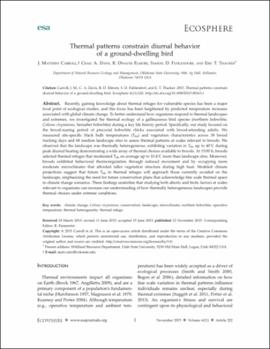| dc.contributor.author | Carroll, J. Matthew | |
| dc.contributor.author | Davis, Craig A. | |
| dc.contributor.author | Elmore, R. Dwayne | |
| dc.contributor.author | Fuhlendorf, Samuel D. | |
| dc.contributor.author | Thacker, Eric T. | |
| dc.date.accessioned | 2019-08-22T17:50:43Z | |
| dc.date.available | 2019-08-22T17:50:43Z | |
| dc.date.issued | 2015-11-12 | |
| dc.identifier | oksd_carroll_thermalpatterns_2015 | |
| dc.identifier.citation | Carroll, J. M., Davis, C. A., Elmore, R. D., Fuhlendorf, S. D., & Thacker, E. T. (2015). Thermal patterns constrain diurnal behavior of a ground-dwelling bird. Ecosphere, 6(11), Article 222. https://doi.org/10.1890/ES15-00163.1 | |
| dc.identifier.uri | https://hdl.handle.net/11244/321222 | |
| dc.description.abstract | Recently, gaining knowledge about thermal refuges for vulnerable species has been a major focal point of ecological studies, and this focus has been heightened by predicted temperature increases associated with global climate change. To better understand how organisms respond to thermal landscapes and extremes, we investigated the thermal ecology of a gallinaceous bird species (northern bobwhite; Colinus virginianus, hereafter bobwhite) during a key life history period. Specifically, our study focused on the brood-rearing period of precocial bobwhite chicks associated with brood-attending adults. We measured site-specific black bulb temperatures (Tbb) and vegetation characteristics across 38 brood tracking days and 68 random landscape sites to assess thermal patterns at scales relevant to broods. We observed that the landscape was thermally heterogeneous, exhibiting variation in Tbb up to 40°C during peak diurnal heating demonstrating a wide array of thermal choices available to broods. At 15:00 h, broods selected thermal refuges that moderated Tbb on average up to 10.4°C more than landscape sites. Moreover, broods exhibited behavioral thermoregulation through reduced movement and by occupying more moderate microclimates that afforded taller vegetation structure during high heat. Modeled climate projections suggest that future Tbb in thermal refuges will approach those currently avoided on the landscape, emphasizing the need for future conservation plans that acknowledge fine scale thermal space in climate change scenarios. These findings underline that studying both abiotic and biotic factors at scales relevant to organisms can increase our understanding of how thermally heterogeneous landscapes provide thermal choices under extreme conditions. | |
| dc.format | application/pdf | |
| dc.language | en_US | |
| dc.publisher | Ecological Society of America | |
| dc.rights | This material has been previously published. In the Oklahoma State University Library's institutional repository this version is made available through the open access principles and the terms of agreement/consent between the author(s) and the publisher. The permission policy on the use, reproduction or distribution of the material falls under fair use for educational, scholarship, and research purposes. Contact Digital Resources and Discovery Services at lib-dls@okstate.edu or 405-744-9161 for further information. | |
| dc.title | Thermal patterns constrain diurnal behavior of a ground-dwelling bird | |
| osu.filename | oksd_carroll_thermalpatterns_2015.pdf | |
| dc.description.peerreview | Peer reviewed | |
| dc.identifier.doi | 10.1890/ES15-00163.1 | |
| dc.description.department | Natural Resource Ecology and Management | |
| dc.type.genre | Article | |
| dc.type.material | Text | |
| dc.subject.keywords | climate change | |
| dc.subject.keywords | colinus virginianus | |
| dc.subject.keywords | conservation | |
| dc.subject.keywords | landscape | |
| dc.subject.keywords | microclimate | |
| dc.subject.keywords | northern bobwhite | |
| dc.subject.keywords | operative temperature | |
| dc.subject.keywords | thermal heterogeneity | |
| dc.subject.keywords | thermal refuge | |
